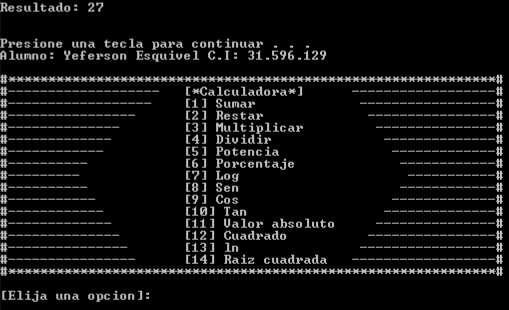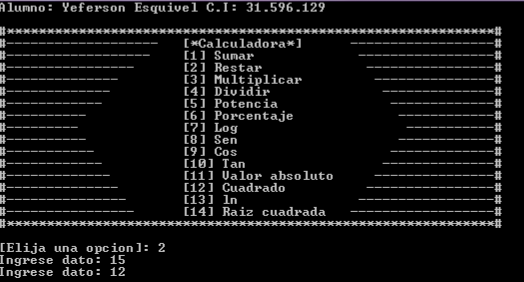[ESP-ENG] Calculadora cientifica en lenguaje de programacion C++ / Scientific calculator made in C++ programming language.
Bienvenido al manual de uso para la calculadora científica Harmony
Harmony es una calculadora científica creada por Yeferson Esquivel estudiante universitario del PNF Informática en la Unesur (Universidad Experimental Sur del Lago), donde se le pide en la unidad curricular “Algorítmica” que realice una calculadora científica en el lenguaje de programación CPP o C++, donde escogió 14 opciones que posee una calculadora científica.

Hablemos un poco de la interfaz con la que viene Harmony, la cual nos da 14 opciones para calcular, las cuales sería: Sumar, Restar, Multiplicar, Dividir, Potencia, Porcentaje, Logaritmo, Seno, Coseno, Tangente, Valor absoluto, Cuadrado, Logaritmo natural y Raíz cuadrada.

Empecemos con la suma, primero deberemos colocar el numero de la opción, en este caso el 1, después Harmony nos pedira 2 conjuntos de números para realizar la suma deseada, en este caso son el 15 y el 12.

Una vez realizada la suma deseada, Harmony cerrara por completo el menú anterior para solamente dejar el resultado que deseabas, si quieres volver al menú, solo debes presionar cualquier tecla y volverás a ver el menú de opciones que tiene Harmony.

Quedará así una vez que presionemos cualquier tecla, nos enviará nuevamente al menú junto con el resultado de la opción anterior.

Pasemos a la opción de resta, donde nuevamente Harmony nos pedirá 2 conjuntos de números para realizar la operación, en este caso: 12 y 15, son los datos ingresados.

Nos lanzara inmediatamente el resultado deseado de la resta, como ejemplo de los datos ingresados anteriormente, conseguimos como resultado: 3.

Como tercera opción tenemos la multiplicación de 2 datos ingresados, Harmony solo realiza operaciones con 2 datos ingresados, sin importar que sean decimales o enteros.

El resultado de la multiplicación anterior es: 96. Podemos realizar multiplicaciones con decimales también y Harmony nos reflejara el resultado junto con los decimales deseados.

Como cuarta opción, tenemos la división donde colocaremos datos en decimales los cuales serían: 25.50/8.

Harmony nos reflejó un el resultado de la división anterior, los cuales fueron verificados y se comprobó que el resultado fue acertado.
Por ahora solo se ejecutarán esas 4 operaciones, sin embargo, las 14 opciones se encuentran funcionales arrojando resultados acertados.
Harmony es una herramienta en desarrollo con funciones de una calculadora científica.
MUCHAS GRACIAS POR PREFERIR A HARMONY
Código de Harmony
En esta sección se revelará el código de Harmony, en el lenguaje CPP o C++, si tienes el conocimiento para leer el código, eres mas que bienvenido a dejar un comentario con opiniones acerca del mismo, si no puedes leer el código, en la próxima publicación estaré enseñando como crear tu propia calculadora científica, donde creare otro código fuente parecido al de Harmony.
#include
#include<math.h>
#include
#include
#define PI 3.1415926536
using namespace std;
int main(){
int opcion;
float r1, r2, res;
do{
cout<<"Alumno: Yeferson Esquivel C.I: 31.596.129\n"<<endl;
cout<<"#*************************************************************#\n";
cout<<"#------------------- [*Calculadora*] ------------------#\n";
cout<<"#------------------ [1] Sumar -----------------#\n";
cout<<"#---------------- [2] Restar ----------------#\n";
cout<<"#-------------- [3] Multiplicar ---------------#\n";
cout<<"#------------- [4] Dividir --------------#\n";
cout<<"#------------ [5] Potencia -------------#\n";
cout<<"#---------- [6] Porcentaje ------------#\n";
cout<<"#--------- [7] Log -----------#\n";
cout<<"#---------- [8] Sen ------------#\n";
cout<<"#----------- [9] Cos -------------#\n";
cout<<"#------------ [10] Tan --------------#\n";
cout<<"#------------- [11] Valor absoluto ---------------#\n";
cout<<"#-------------- [12] Cuadrado ----------------#\n";
cout<<"#--------------- [13] ln -----------------#\n";
cout<<"#---------------- [14] Raiz cuadrada ------------------#\n";
cout<<"#*************************************************************#\n";
cout<<"\n[Elija una opcion]: ";
cin>>opcion;
switch(opcion){
case 1:
cout<<"Ingrese dato: "; cin>>r1;
cout<<"Ingrese dato: "; cin>>r2;
system("cls");
res = r1 + r2;
cout<<"\nResultado: "<<res<<endl;
break;
case 2:
cout<<"Ingrese dato: "; cin>>r1;
cout<<"Ingrese dato: "; cin>>r2;
system("cls");
res = r1 - r2;
cout<<"\nResultado: "<<res<<endl;
break;
case 3:
cout<<"Ingrese dato: "; cin>>r1;
cout<<"Ingrese dato: "; cin>>r2;
system("cls");
res = r1*r2;
cout<<"\nResultado: "<<res<<endl;
break;
case 4:
cout<<"Ingrese dato: "; cin>>r1;
cout<<"Ingrese dato: "; cin>>r2;
system("cls");
res = r1/r2;
cout<<"\nResultado: "<<res<<endl;
break;
case 5:
cout<<"Ingrese dato: "; cin>>r1;
cout<<"Ingrese dato: "; cin>>r2;
system("cls");
res = (pow(r1,r2));
cout<<"\nResultado es: "<<res<<endl;
break;
case 6:
cout<<"Ingrese dato: "; cin>>r1;
cout<<"Ingrese dato: "; cin>>r2;
system("cls");
res = r1*(r2/100);
cout<<"\nResultado: "<<res<<endl;
break;
case 7:
cout<<"Ingrese dato: "; cin>>r1;
system("cls");
res = log10(r1);
cout<<"\nResultado: "<<res<<endl;
break;
case 8:
cout<<"Ingrese dato: "; cin>>r1;
system("cls");
res = sin(r1/180*PI);
cout<<"\nResultado: "<<res<<endl;
break;
case 9:
cout<<"Ingrese dato: "; cin>>r1;
system("cls");
res = cos(r1/180*PI);
cout<<"\nResultado: "<<res<<endl;
break;
case 10:
cout<<"Ingrese dato: "; cin>>r1;
system("cls");
res = tan(r1/180*PI);
cout<<"\nResultado: "<<res<<endl;
break;
case 11:
cout<<"Ingrese dato: "; cin>>r1;
system("cls");
res = abs(r1);
cout<<"\nResultado: "<<res<<endl;
break;
case 12:
cout<<"Ingrese dato: "; cin>>r1;
system("cls");
res = (pow(r1,2));
cout<<"\nResultado: "<<res<<endl;
break;
case 13:
cout<<"Ingrese dato: "; cin>>r1;
system("cls");
res = log(r1);
cout<<"\nResultado: "<<res<<endl;
break;
case 14:
cout<<"Ingrese dato: "; cin>>r1;
system("cls");
res = sqrt(r1);
cout<<"\nResultado: "<<res<<endl;
break;
default:
cout<<"\nIngrese una opcion valida";
break;
}
cout<<"\n\n";
system("pause");
}while(opcion <=14);
return 0;
}
Espero que te haya gustado esta breve publicación donde solamente se enseña el código de una calculadora científica con solo 14 operaciones y una prueba de que esta totalmente funcional, si estas interesado o interesada en ver el paso a paso de cómo crear esta calculadora, te invito a leer mi próxima publicación.
*Bibliografía+
Creación de calculadora básica en C++
ENGLISH
Welcome friends to this new publication where I will show you a scientific calculator with 14 operations, created entirely by me and is functional. For those who are interested in testing if it works, I invite you to copy the source code and try it on your computers or phones.
Welcome to the user manual for the Harmony scientific calculator
Harmony is a scientific calculator created by Yeferson Esquivel university student of PNF Informática at Unesur (Universidad Experimental Sur del Lago), where he is asked in the curricular unit "Algorithmics" to make a scientific calculator in the programming language CPP or C++, where he chose 14 options that a scientific calculator has.

Let's talk a little about the interface that Harmony comes with, which gives us 14 options to calculate, which would be: Add, Subtract, Multiply, Divide, Power, Percentage, Logarithm, Sine, Cosine, Tangent, Absolute Value, Square, Natural Logarithm and Square Root.

Let's start with the sum, first we must place the option number, in this case 1, then Harmony will ask us for 2 sets of numbers to perform the desired sum, in this case they are 15 and 12.

Once the desired sum is done, Harmony will completely close the previous menu to only leave the result you wanted, if you want to return to the menu, just press any key and you will see again the menu of options that Harmony has.

It will look like this once we press any key, it will send us back to the menu along with the result of the previous option.

Let's move on to the subtraction option, where again Harmony will ask us for 2 sets of numbers to perform the operation, in this case: 12 and 15, are the data entered.

It will immediately throw us the desired result of the subtraction, as an example of the data entered above, we get as a result: 3.

As a third option we have the multiplication of 2 entered data, Harmony only performs operations with 2 entered data, no matter if they are decimals or integers.

The result of the above multiplication is: 96. We can perform multiplications with decimals as well and Harmony will reflect the result along with the desired decimals.

As a fourth option, we have the division where we will place data in decimals which would be: 25.50/8.

Harmony reflected us a the result of the previous division, which were verified and it was verified that the result was correct.
For now only those 4 operations will be executed, however, all 14 options are functional and yielding successful results.
Harmony is a tool under development with functions of a scientific calculator.
THANK YOU VERY MUCH FOR PREFERRING HARMONY
Harmony code
In this section will be revealed the Harmony code, in CPP or C++ language, if you have the knowledge to read the code, you are more than welcome to leave a comment with opinions about it, if you can't read the code, in the next publication I will be teaching how to create your own scientific calculator, where I will create another source code similar to Harmony.
#include
#include<math.h>
#include
#include
#define PI 3.1415926536
using namespace std;
int main(){
int opcion;
float r1, r2, res;
do{
cout<<"Alumno: Yeferson Esquivel C.I: 31.596.129\n"<<endl;
cout<<"#*************************************************************#\n";
cout<<"#------------------- [*Calculadora*] ------------------#\n";
cout<<"#------------------ [1] Sumar -----------------#\n";
cout<<"#---------------- [2] Restar ----------------#\n";
cout<<"#-------------- [3] Multiplicar ---------------#\n";
cout<<"#------------- [4] Dividir --------------#\n";
cout<<"#------------ [5] Potencia -------------#\n";
cout<<"#---------- [6] Porcentaje ------------#\n";
cout<<"#--------- [7] Log -----------#\n";
cout<<"#---------- [8] Sen ------------#\n";
cout<<"#----------- [9] Cos -------------#\n";
cout<<"#------------ [10] Tan --------------#\n";
cout<<"#------------- [11] Valor absoluto ---------------#\n";
cout<<"#-------------- [12] Cuadrado ----------------#\n";
cout<<"#--------------- [13] ln -----------------#\n";
cout<<"#---------------- [14] Raiz cuadrada ------------------#\n";
cout<<"#*************************************************************#\n";
cout<<"\n[Elija una opcion]: ";
cin>>opcion;
switch(opcion){
case 1:
cout<<"Ingrese dato: "; cin>>r1;
cout<<"Ingrese dato: "; cin>>r2;
system("cls");
res = r1 + r2;
cout<<"\nResultado: "<<res<<endl;
break;
case 2:
cout<<"Ingrese dato: "; cin>>r1;
cout<<"Ingrese dato: "; cin>>r2;
system("cls");
res = r1 - r2;
cout<<"\nResultado: "<<res<<endl;
break;
case 3:
cout<<"Ingrese dato: "; cin>>r1;
cout<<"Ingrese dato: "; cin>>r2;
system("cls");
res = r1*r2;
cout<<"\nResultado: "<<res<<endl;
break;
case 4:
cout<<"Ingrese dato: "; cin>>r1;
cout<<"Ingrese dato: "; cin>>r2;
system("cls");
res = r1/r2;
cout<<"\nResultado: "<<res<<endl;
break;
case 5:
cout<<"Ingrese dato: "; cin>>r1;
cout<<"Ingrese dato: "; cin>>r2;
system("cls");
res = (pow(r1,r2));
cout<<"\nResultado es: "<<res<<endl;
break;
case 6:
cout<<"Ingrese dato: "; cin>>r1;
cout<<"Ingrese dato: "; cin>>r2;
system("cls");
res = r1*(r2/100);
cout<<"\nResultado: "<<res<<endl;
break;
case 7:
cout<<"Ingrese dato: "; cin>>r1;
system("cls");
res = log10(r1);
cout<<"\nResultado: "<<res<<endl;
break;
case 8:
cout<<"Ingrese dato: "; cin>>r1;
system("cls");
res = sin(r1/180*PI);
cout<<"\nResultado: "<<res<<endl;
break;
case 9:
cout<<"Ingrese dato: "; cin>>r1;
system("cls");
res = cos(r1/180*PI);
cout<<"\nResultado: "<<res<<endl;
break;
case 10:
cout<<"Ingrese dato: "; cin>>r1;
system("cls");
res = tan(r1/180*PI);
cout<<"\nResultado: "<<res<<endl;
break;
case 11:
cout<<"Ingrese dato: "; cin>>r1;
system("cls");
res = abs(r1);
cout<<"\nResultado: "<<res<<endl;
break;
case 12:
cout<<"Ingrese dato: "; cin>>r1;
system("cls");
res = (pow(r1,2));
cout<<"\nResultado: "<<res<<endl;
break;
case 13:
cout<<"Ingrese dato: "; cin>>r1;
system("cls");
res = log(r1);
cout<<"\nResultado: "<<res<<endl;
break;
case 14:
cout<<"Ingrese dato: "; cin>>r1;
system("cls");
res = sqrt(r1);
cout<<"\nResultado: "<<res<<endl;
break;
default:
cout<<"\nIngrese una opcion valida";
break;
}
cout<<"\n\n";
system("pause");
}while(opcion <=14);
return 0;
}
I hope you liked this brief publication where only the code of a scientific calculator with only 14 operations and a proof that it is fully functional is taught, if you are interested in seeing the step by step of how to create this calculator, I invite you to read my next publication.
*Bibliography+ .
Congratulations @gaming.yer! You have completed the following achievement on the Hive blockchain And have been rewarded with New badge(s)
Your next target is to reach 900 comments.
You can view your badges on your board and compare yourself to others in the Ranking
If you no longer want to receive notifications, reply to this comment with the word
STOPCheck out our last posts: